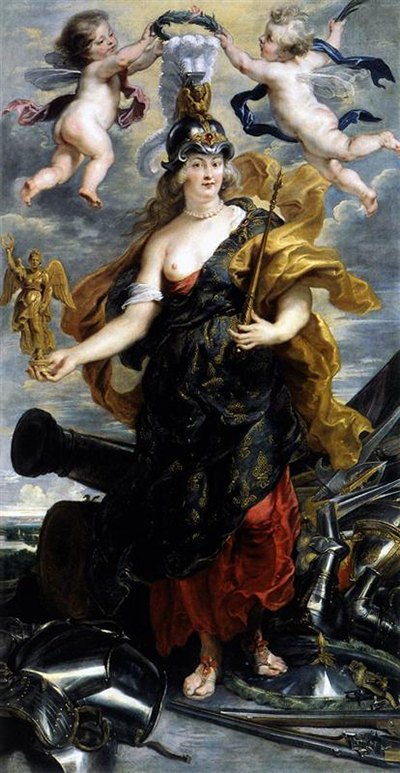The portrait of Marie de Medicis as Bellona by Peter Paul Rubens was painted in 1625 as oil on canvas. Marie de Medici commissioned Rubens to paint her in a series of portraits.
The series of twenty four paintings was begun by Rubens in 1621, and saw Marie de Medici's life shown as overseen by a number of different Gods and Goddesses, with the underlying themes of success and triumph always evident. Marie de Medicis as Bellona by Peter Paul Rubens is an overtly flattering portrait of Marie de Medici that sees her depicted as Bellona.
Bellona was the Roman Goddess of War, and here Rubens shows Marie de Medici leaning against a cannon, the armour of defeated enemies at her feet, two cherubs adoring her helmet with the civic crown. The civic crown was one of the highest honours a citizen could receive in Ancient Rome, and Rubens uses this allegorical device to celebrate Marie de Medicis stature as regent.
Rubens was considered one of the most talented artists in Northern Europe at the time, and was well equip to take on such a great commission, with previous commissions including his works for the Archduchess Isabella.
Marie de Medici was by this point in her life the widow of Henry IV, which was her greatest noted achievement in life, with all six of their children having died in infancy, with their sole surviving son Louis too young to succeed the throne at the time of his father's death. The Medici family were long embroiled in political scandal, and Rubens series of portraits of Marie de Medici wisely steer clear of any reference to this.
Instead, Rubens combined his extensive knowledge of classical mythology and history to see Marie de Medici glorified in a positive light, always surrounded by Gods and Goddesses.
Marie de Medici was unpopular with the French people, and after her husband's assassination in 1610, was appointed Regent by French Salic Law. The Medici cycle of paintings were not only commissioned to adorn the walls of the Luxembourg Palace, her residence in Paris, but to act as propaganda through allegory. Marie de Medicis as Bellona by Peter Paul Rubens shows her as the seminude Bellona, who stands to unite rather than to divide.
By the time of the commission, over a decade had passed since her husband's death, but the French aristocracy still rejected this female Italian as ruler, and the cycle as such tries to elevate Marie de Medici and encourage support for her as Regent.




